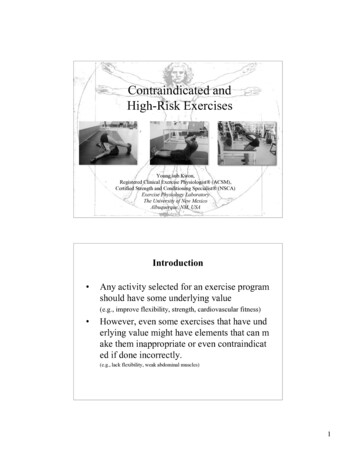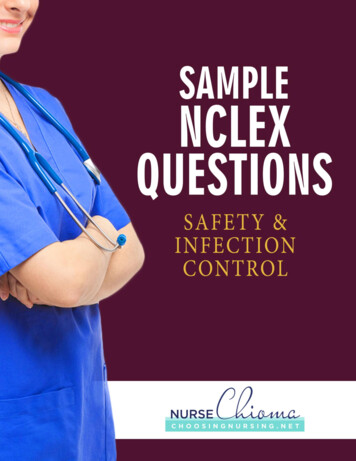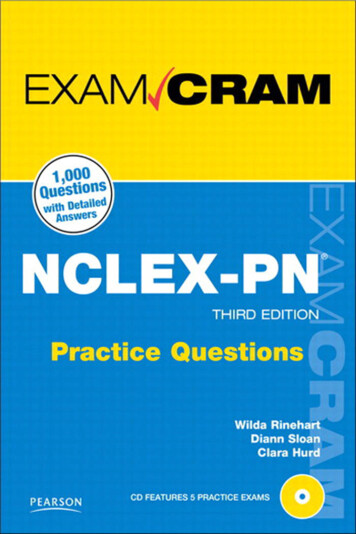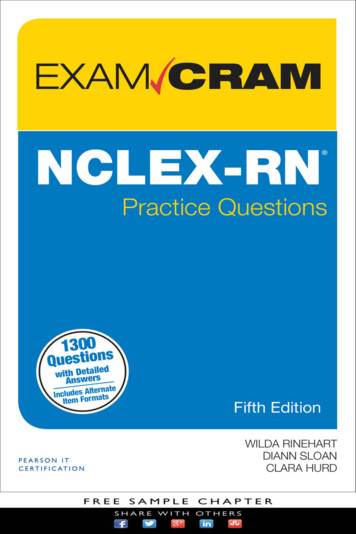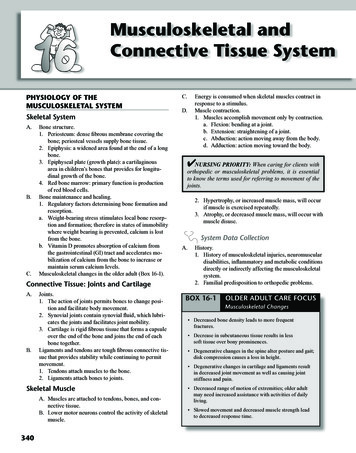
Transcription
73397 FMxx FINAL.QXD4/8/102:21 PMPage iNCLEX High-Risk The Disaster Prevention Manualfor Nurses Determined to Passthe RN Licensing ExaminationMarian C. Condon, DEd, RN, CNEProfessorDepartment of NursingYork College of PennsylvaniaYork, PennsylvaniaKaren S. March, PhD, RN, CCRN, ACNS-BCProfessorDepartment of NursingYork College of PennsylvaniaYork, Pennsylvania
73397 FMxx FINAL.QXD4/8/102:21 PMWorld HeadquartersJones & Bartlett Learning40 Tall Pine DriveSudbury, MA .comPage iiJones & Bartlett Learning Canada6339 Ormindale WayMississauga, Ontario L5V 1J2CanadaJones & Bartlett Learning InternationalBarb House, Barb MewsLondon W6 7PAUnited KingdomJones & Bartlett Learning books and products are available through most bookstores and online booksellers. Tocontact Jones & Bartlett Learning directly, call 800-832-0034, fax 978-443-8000, or visit our website,www.jblearning.com.Substantial discounts on bulk quantities of Jones & Bartlett Learning publications are available to corporations, professional associations, and other qualified organizations. For details and specific discount information, contact the special sales department at Jones & Bartlett Learning via the above contact information orsend an email to specialsales@jblearning.com.Copyright 2011 by Jones & Bartlett Learning, LLCAll rights reserved. No part of the material protected by this copyright may be reproduced or utilized in anyform, electronic or mechanical, including photocopying, recording, or by any information storage andretrieval system, without written permission from the copyright owner.The authors, editor, and publisher have made every effort to provide accurate information. However, they are notresponsible for errors, omissions, or for any outcomes related to the use of the contents of this book and take noresponsibility for the use of the products and procedures described. Treatments and side effects described in thisbook may not be applicable to all people; likewise, some people may require a dose or experience a side effectthat is not described herein. Drugs and medical devices are discussed that may have limited availability controlled by the Food and Drug Administration (FDA) for use only in a research study or clinical trial. Research,clinical practice, and government regulations often change the accepted standard in this field. When consideration is being given to use of any drug in the clinical setting, the health care provider or reader is responsible fordetermining FDA status of the drug, reading the package insert, and reviewing prescribing information for themost up-to-date recommendations on dose, precautions, and contraindications, and determining the appropriateusage for the product. This is especially important in the case of drugs that are new or seldom used.Production CreditsPublisher: Kevin SullivanAcquisitions Editor: Amy SibleyAssociate Editor: Patricia DonnellyEditorial Assistant: Rachel ShusterAssociate Production Editor: Lisa CerroneMarketing Manager: Rebecca WasleyV.P., Manufacturing and Inventory Control: Therese ConnellComposition: Paw Print MediaCover Design: Scott ModenCover Image: Taewoon Lee/ShutterStock, Inc.Printing and Binding: Courier StoughtonCover Printing: Courier StoughtonLibrary of Congress Cataloging-in-Publication DataNCLEX high-risk : the disaster prevention manual for nurses determined to pass the RN licensing examination/ Marian C. Condon, Karen S. March.p. ; cm.Includes bibliographical references.ISBN 978-0-7637-7339-7 (pbk.)1. Practical nursing—Examinations, questions, etc. 2. Nursing care—Examinations, questions, etc. I. Condon,Marian C. II. March, Karen S.[DNLM: 1. Nursing—Examination Questions. 2. Nursing—Examination Questions. WY 18.2 N3363 2011]RT62.N3364 2011610.73076—dc2220100080766048Printed in the United States of America14 13 12 11 10 10 9 8 7 6 5 4 3 2 1
4/8/102:21 PMPage iiiDedicationThis book is dedicated to my beloved sons, Patrick and Adam Hooper: Labor was worthit, sweethearts—you are the lights of my life. It is also dedicated to the many graduatenurses I’ve been privileged to assist in their quest to finally pass the NCLEX. I wouldlike to direct special thanks to Betty DeMeester Webster and Michelle Metz Robinson,who were my very first clients, and to the 25 graduate nurses who allowed me to interview them in 1992 and 1993 as part of my doctoral dissertation research: You were myfirst teachers, and it was you who launched me on the journey of understanding that has culminated in the publication of this book. You will always hold a special place in my heart.—M.C.C.iii I would like to dedicate this book to graduate nurses of the past, present, and future,who inspired my commitment to this project, and to Brad and Zach, who have provided love, encouragement, support, and most of all, patience, throughout the weeksand months of writing. I do what I do because of you.—K.S.M. 73397 FMxx FINAL.QXD
73397 FMxx FINAL.QXD4/8/102:21 PMPage iv
73397 FMxx FINAL.QXD4/8/102:21 PMPage vContentsChapter 3:Should You Buy This Book? . . . . . . . . . . . . . . . . . . . . . . . . . . . . . . .xiiForeword . . . . . . . . . . . . . . . . . . . . . . . . . . . . . . . . . . . . . . . . . . . . . .xiiiAcknowledgments . . . . . . . . . . . . . . . . . . . . . . . . . . . . . . . . . . . . . .xvIntroduction: How to Get the Most Out of This Book . . . . . . . . . .Marian C. CondonWhy You Should Read Most of the Chapters in Order . . . . . . . . . . .Why You Should Keep Track of Your Progress . . . . . . . . . . . . . . . . . .Why You Should Create and Review Nugget Lists . . . . . . . . . . . . . .Why You Should Make Preparing for NCLEX an Absolute Priority . .Why You Should Access a Source of Additional Questions,If Necessary . . . . . . . . . . . . . . . . . . . . . . . . . . . . . . . . . . . . . . . . . . .How to Know Whether You Need a Tutor . . . . . . . . . . . . . . . . . . . . .xviixviixviiixixxxxxxxAre You at Risk for Failing NCLEX ? . . . . . . . . . . . . . . . . . . . . . . .Marian C. CondonRisk Factors . . . . . . . . . . . . . . . . . . . . . . . . . . . . . . . . . . . . . . . . . . . . .What It’s Like to Fail . . . . . . . . . . . . . . . . . . . . . . . . . . . . . . . . . . . . .Being at Risk for Failing NCLEX Does Not Mean You Will NeverBe a Good Nurse . . . . . . . . . . . . . . . . . . . . . . . . . . . . . . . . . . . . . . .References . . . . . . . . . . . . . . . . . . . . . . . . . . . . . . . . . . . . . . . . . . . . . .1Are You Using the Right NCLEX Prep Strategies? . . . . . . . . . . . . .Marian C. CondonIneffective Prep Strategies . . . . . . . . . . . . . . . . . . . . . . . . . . . . . . . . .Two Things You Must Do If You Want to Pass the NCLEX . . . . . . . .When to Start Studying for NCLEX . . . . . . . . . . . . . . . . . . . . . . . . . .Review Courses . . . . . . . . . . . . . . . . . . . . . . . . . . . . . . . . . . . . . . . . . .Test Anxiety . . . . . . . . . . . . . . . . . . . . . . . . . . . . . . . . . . . . . . . . . . . .References . . . . . . . . . . . . . . . . . . . . . . . . . . . . . . . . . . . . . . . . . . . . . .11NCLEX-RN : Purpose, Format, and Scope . . . . . . . . . . . . . . . . . . .Marian C. CondonHow the Exam Is Developed and Administered . . . . . . . . . . . . . . . .17v Chapter 2:xi Chapter 1:Letter to Nursing Students . . . . . . . . . . . . . . . . . . . . . . . . . . . . . . . .167811131415161617
73397 FMxx FINAL.QXDvi 4/8/102:21 PMPage viContentsChapter 4:Chapter 5:Chapter 6:How the Questions Are Written and Structured . . . . . . . . . . . . . . . .What You Will Be Expected to Know: The NCLEX Test Plan . . . . . . .References . . . . . . . . . . . . . . . . . . . . . . . . . . . . . . . . . . . . . . . . . . . . . .172223CAT-Anatomy: How Computer-Adaptive Testing Works . . . . . . .Marian C. CondonWhat Computer-Adaptive Testing Is . . . . . . . . . . . . . . . . . . . . . . . . .How NCLEX Is Scored . . . . . . . . . . . . . . . . . . . . . . . . . . . . . . . . . . . .Test-Taking Strategies You Should Never Use on NCLEX . . . . . . . . . .References . . . . . . . . . . . . . . . . . . . . . . . . . . . . . . . . . . . . . . . . . . . . . .25Registration, Results, and Test-Center Smarts . . . . . . . . . . . . . . . .Marian C. CondonHow to Register to Take NCLEX . . . . . . . . . . . . . . . . . . . . . . . . . . . . .Avoiding Pretest Disasters . . . . . . . . . . . . . . . . . . . . . . . . . . . . . . . . .What to Expect at the Test Center . . . . . . . . . . . . . . . . . . . . . . . . . . .What You Don’t Have to Worry About . . . . . . . . . . . . . . . . . . . . . . .Getting Your Results . . . . . . . . . . . . . . . . . . . . . . . . . . . . . . . . . . . . . .Reference . . . . . . . . . . . . . . . . . . . . . . . . . . . . . . . . . . . . . . . . . . . . . .29Test Yourself: How Good Are You at Doping Out Test Questions?Marian C. CondonHow Well Do You Analyze Test Questions? . . . . . . . . . . . . . . . . . . . .The Optimal Question-Analyzing Process . . . . . . . . . . . . . . . . . . . . .Chapter 7:Chapter 8:25252627293030313132333334Test Yourself: How Good Is Your Knowledge Base? . . . . . . . . . . . .Marian C. Condon and Karen S. MarchIntroduction . . . . . . . . . . . . . . . . . . . . . . . . . . . . . . . . . . . . . . . . . . . .Comprehensive Practice Exam 1 . . . . . . . . . . . . . . . . . . . . . . . . . . . .Answers . . . . . . . . . . . . . . . . . . . . . . . . . . . . . . . . . . . . . . . . . . . . . . .43How to Use What You Don’t Know to Pass the NCLEX . . . . . . . . .Marian C. CondonThe Nugget Method . . . . . . . . . . . . . . . . . . . . . . . . . . . . . . . . . . . . . .Strategies for Enhancing Memory and Retention . . . . . . . . . . . . . . .The Basics of Memorization . . . . . . . . . . . . . . . . . . . . . . . . . . . . . . .Preferred Learning Styles . . . . . . . . . . . . . . . . . . . . . . . . . . . . . . . . . .Using Visualization to Enhance Memory . . . . . . . . . . . . . . . . . . . . .Designing and Timing Your Study Sessions for Maximal RetentionUsing Keep Track Boxes to Monitor Your Progress . . . . . . . . . . . . . .References . . . . . . . . . . . . . . . . . . . . . . . . . . . . . . . . . . . . . . . . . . . . . .594344535965656868717274
73397 FMxx FINAL.QXD4/8/102:21 PMPage viiContents Chapter 9:Chapter 10:Practice Test: Nursing Management of Patients withCardiac Disorders . . . . . . . . . . . . . . . . . . . . . . . . . . . . . . . . . . . . . . .Karen S. MarchPractice Test . . . . . . . . . . . . . . . . . . . . . . . . . . . . . . . . . . . . . . . . . . . .Answers . . . . . . . . . . . . . . . . . . . . . . . . . . . . . . . . . . . . . . . . . . . . . . .Practice Test: Nursing Management of Patients withVascular Disorders . . . . . . . . . . . . . . . . . . . . . . . . . . . . . . . . . . . . . .Karen S. MarchPractice Test . . . . . . . . . . . . . . . . . . . . . . . . . . . . . . . . . . . . . . . . . . . .Answers . . . . . . . . . . . . . . . . . . . . . . . . . . . . . . . . . . . . . . . . . . . . . . .Chapter 11:Chapter 12:Practice Test: Nursing Management of Patients with RespiratoryDisorders . . . . . . . . . . . . . . . . . . . . . . . . . . . . . . . . . . . . . . . . . . . . . .Karen S. MarchPractice Test . . . . . . . . . . . . . . . . . . . . . . . . . . . . . . . . . . . . . . . . . . . .Answers . . . . . . . . . . . . . . . . . . . . . . . . . . . . . . . . . . . . . . . . . . . . . . .Practice Test: Nursing Management of Patients withNeurologic Disorders . . . . . . . . . . . . . . . . . . . . . . . . . . . . . . . . . . . .Karen S. MarchPractice Test . . . . . . . . . . . . . . . . . . . . . . . . . . . . . . . . . . . . . . . . . . . .Answers . . . . . . . . . . . . . . . . . . . . . . . . . . . . . . . . . . . . . . . . . . . . . . .Chapter 13:Chapter 14:Chapter 15:Practice Test: Nursing Management of Patients with Psychiatricand Mental Health Disorders . . . . . . . . . . . . . . . . . . . . . . . . . . . . .Karen S. MarchPractice Test . . . . . . . . . . . . . . . . . . . . . . . . . . . . . . . . . . . . . . . . . . . .Answers . . . . . . . . . . . . . . . . . . . . . . . . . . . . . . . . . . . . . . . . . . . . . . .Practice Test: Nursing Management of Patients with Renal andUrinary Tract Disorders . . . . . . . . . . . . . . . . . . . . . . . . . . . . . . . . . .Karen S. MarchPractice Test . . . . . . . . . . . . . . . . . . . . . . . . . . . . . . . . . . . . . . . . . . . .Answers . . . . . . . . . . . . . . . . . . . . . . . . . . . . . . . . . . . . . . . . . . . . . . .Practice Test: Nursing Management of Patients withHematologic Disorders . . . . . . . . . . . . . . . . . . . . . . . . . . . . . . . . . .Karen S. MarchPractice Test . . . . . . . . . . . . . . . . . . . . . . . . . . . . . . . . . . . . . . . . . . . .Answers . . . . . . . . . . . . . . . . . . . . . . . . . . . . . . . . . . . . . . . . . . . . . . 181189189197
73397 FMxx FINAL.QXDviii 4/8/102:21 PMPage viiiContentsChapter 16:Chapter 17:Practice Test: Nursing Management of Patients withMusculoskeletal Disorders . . . . . . . . . . . . . . . . . . . . . . . . . . . . . . . .Karen S. MarchPractice Test . . . . . . . . . . . . . . . . . . . . . . . . . . . . . . . . . . . . . . . . . . . .Answers . . . . . . . . . . . . . . . . . . . . . . . . . . . . . . . . . . . . . . . . . . . . . . .Practice Test: Nursing Management of Patients with GI andBiliary Tract Disorders . . . . . . . . . . . . . . . . . . . . . . . . . . . . . . . . . . .Karen S. MarchPractice Test . . . . . . . . . . . . . . . . . . . . . . . . . . . . . . . . . . . . . . . . . . . .Answers . . . . . . . . . . . . . . . . . . . . . . . . . . . . . . . . . . . . . . . . . . . . . . .Chapter 18:Practice Test: Nursing Management of Patients withEndocrine Disorders . . . . . . . . . . . . . . . . . . . . . . . . . . . . . . . . . . . . .Karen S. MarchPractice Test . . . . . . . . . . . . . . . . . . . . . . . . . . . . . . . . . . . . . . . . . . . .Answers . . . . . . . . . . . . . . . . . . . . . . . . . . . . . . . . . . . . . . . . . . . . . . .203203210217217228237237250Chapter 19:Practice Test: Nursing Management of Patients with ReproductiveSystem Disorders . . . . . . . . . . . . . . . . . . . . . . . . . . . . . . . . . . . . . . . .257Karen S. MarchPractice Test . . . . . . . . . . . . . . . . . . . . . . . . . . . . . . . . . . . . . . . . . . . .257Answers . . . . . . . . . . . . . . . . . . . . . . . . . . . . . . . . . . . . . . . . . . . . . . .262Chapter 20:Practice Test: Nursing Management of Childbearing Womenand Newborns . . . . . . . . . . . . . . . . . . . . . . . . . . . . . . . . . . . . . . . . . .Karen S. MarchPractice Test . . . . . . . . . . . . . . . . . . . . . . . . . . . . . . . . . . . . . . . . . . . .Answers . . . . . . . . . . . . . . . . . . . . . . . . . . . . . . . . . . . . . . . . . . . . . . .Chapter 21:Chapter 22:Practice Test: Nursing Management of PatientsUndergoing Surgery . . . . . . . . . . . . . . . . . . . . . . . . . . . . . . . . . . . . . . . .Karen S. MarchPractice Test . . . . . . . . . . . . . . . . . . . . . . . . . . . . . . . . . . . . . . . . . . . .Answers . . . . . . . . . . . . . . . . . . . . . . . . . . . . . . . . . . . . . . . . . . . . . . .Practice Test: Nursing Management of Patients Being Treatedfor Cancer . . . . . . . . . . . . . . . . . . . . . . . . . . . . . . . . . . . . . . . . . . . . .Karen S. MarchPractice Test . . . . . . . . . . . . . . . . . . . . . . . . . . . . . . . . . . . . . . . . . . . .Answers . . . . . . . . . . . . . . . . . . . . . . . . . . . . . . . . . . . . . . . . . . . . . . .267267276283283286291291297
73397 FMxx FINAL.QXD4/8/102:21 PMPage ixContents Chapter 23:Chapter 24:Chapter 25:ixPractice Test: Leadership . . . . . . . . . . . . . . . . . . . . . . . . . . . . . . . . .Marian C. CondonPractice Test . . . . . . . . . . . . . . . . . . . . . . . . . . . . . . . . . . . . . . . . . . . .Answers . . . . . . . . . . . . . . . . . . . . . . . . . . . . . . . . . . . . . . . . . . . . . . .303Comprehensive Practice Exam 2 . . . . . . . . . . . . . . . . . . . . . . . . . .Karen S. MarchComprehensive Practice Exam . . . . . . . . . . . . . . . . . . . . . . . . . . . . .Answers . . . . . . . . . . . . . . . . . . . . . . . . . . . . . . . . . . . . . . . . . . . . . . .319Comprehensive Practice Exam 3 . . . . . . . . . . . . . . . . . . . . . . . . . .Karen S. MarchComprehensive Practice Exam . . . . . . . . . . . . . . . . . . . . . . . . . . . . .Answers . . . . . . . . . . . . . . . . . . . . . . . . . . . . . . . . . . . . . . . . . . . . . . .347Sources . . . . . . . . . . . . . . . . . . . . . . . . . . . . . . . . . . . . . . . . . . . . . . . .377303311319336347365
73397 FMxx FINAL.QXD4/8/102:21 PMPage x
4/8/102:21 PMPage xiLetter to Nursing StudentsDear Senior Nursing Student or Graduate Nurse,Please do not assume that because you’ve made it through nursing school, you arepretty much guaranteed to pass the NCLEX . Unfortunately, there is no such guarantee—every year, bright, capable new nurses undergo the humiliating and painful experience of taking the RN licensing examination and not being successful.From my interactions with the many GNs I’ve tutored in an effort to help them retakeNCLEX successfully, I know that most either put little or no time into preparing fortheir first attempt, or they wasted their prep time on passive learning strategies thatproved ineffective. Also, I know that many were unaware of the risk factors for failureon NCLEX and did not realize they needed to take extra precautions to ensure thatthey would pass.This book is written especially for GNs who are at higher than average risk for havingto retake the NCLEX. I invite you to take a look at the risk factors listed in Should YouBuy This Book?, and if one or more apply to you, I urge you to take the process ofpreparing for NCLEX very, very seriously.All best wishes for a fulfilling career in nursing,xi Marian Condon 73397 FMxx FINAL.QXD
4/8/102:21 PMPage xiiShould You Buy This Book?If any of the risk factors listed below apply to you, the answer is, “Yes!”You’ve had to struggle to keep your GPA up ( 3.4).You got one or more Cs in a science course or a nursing course.You did better clinically than on classroom tests.You consider yourself to be a hands-on learner as opposed to a book learner.You tend to get the gist of things but have trouble with details.You did poorly on a predictive exit exam such as Evolve REACH (formerly HESI).English is not your native language.You’ve already failed the NCLEX one or more times.xii 73397 FMxx FINAL.QXD
4/8/102:21 PMPage xiiiForewordAs one of her earliest NCLEX clients, I was delighted when Dr. Marian Condon invitedme to write a foreword to this excellent and much-needed book. Here’s my story: I tookthe NCLEX for the first time in the mid-1980s and did not pass. While the majority ofmy classmates were rejoicing over having achieved RN status, I was left feeling embarrassed and mad at myself. I was dreading the thought of retaking the boards and feltextremely pressured because I knew that if I failed again, I would lose my graduatenurse (GN) status at the hospital and would have to assume the role of nursing assistant. Thus, I was devastated when the dreaded large envelope again arrived in themail. I resigned from my job as a GN and wondered about my future.When Dr. Condon, who had been one of my favorite nursing instructors, learned ofmy second failure, she called and asked whether I would like her to tutor me, using anew method she was developing to help students perform better on tests. I felt honored,grateful, and even a bit curious. While I do not remember all of the details of our sessions together, I do recall that I quickly learned that the main reason for my failureswas not test anxiety, as I’d thought, but the fact that I lacked some essential nursingknowledge. With Dr. Condon’s help, I not only passed the boards on my third attempt,but exceeded what was then the passing score by 248 points!Never let anyone tell you that a history of having failed NCLEX one or more timesmeans you’ll never be a successful nurse. Since becoming an RN, I have held staffnurse positions in a variety of hospitals, earned a master’s degree in nursing, andworked for 10 years as a clinical nurse specialist in a neonatal intensive care unit. I amcurrently a nurse coordinator in a nursing program. Ironically, I now find myself sharing with my own nursing students the same study techniques that Dr. Condon taughtme over 25 years ago.Best wishes to all who are reading this!xiii Betty DeMeester Webster, RNC, MSBaltimore, Maryland 73397 FMxx FINAL.QXD
73397 FMxx FINAL.QXD4/8/102:21 PMPage xiv
4/8/102:21 PMPage xvAcknowledgmentsxv We would like to thank our family members and friends for their patience in allowingus to hole up unmolested on weekends and holidays so we could work on The Book andfor graciously sharing their households with The Book for what must have seemed likean awfully long time.We would also like to thank our colleagues in the Department of Nursing at YorkCollege for putting up with our distraction and seeming inability to talk about anythingbut The Book, and for telling us the truth when we asked for their opinion of a page or achapter. Special thanks are due to Professors Brigitte Haagen and Janice Ambrose, wholent us their expertise during the practice test development process. We would also liketo thank Captain Pamela Gray, USN (Ret.), RN, MSN, FNP, who provided invaluablefeedback on the early chapters. And, of course, we absolutely must thank all our helpersat Jones & Bartlett Learning: Amy Sibley, Rachel Shuster, and Lisa Cerrone. 73397 FMxx FINAL.QXD
73397 FMxx FINAL.QXD4/8/102:21 PMPage xvi
73397 FMxx FINAL.QXD4/8/102:21 PMPage xviiIntroduction:How to Get the Most Out of This BookMarian C. CondonWHAT YOU WILL LEARN IN THIS CHAPTER Why you should read the chapters in order.Why you should bother with Keep Track boxes and Nugget Lists.Why you should make preparing for NCLEX an absolute priority.Why you should access a source of additional questions, if necessary.How to know whether you need a tutor.WHY YOU SHOULD READ MOST OF THE CHAPTERS IN ORDERThis book is not merely a source of practice NCLEX questions; it is a blueprint for successful NCLEX preparation, written especially for nurses who are at risk for failure. It isbased on a specific methodology that has proven itself consistently, even with nurseswho have failed NCLEX several times. Because a good deal of thought has gone intothe manner in which this book is organized, you will get more out of it if you readmost of the early chapters in order.Chapter 1, “Are You at Risk for Failing NCLEX?” provides the information you needto evaluate your own degree of risk and aims to boost your motivation to complete theconsiderable amount of work thorough NCLEX preparation requires. Chapter 2, “AreYou Using the Right NCLEX Prep Strategies?,” will provide insight into your thinkingstyle and will help you to make a judgment about how well the study habits you haveacquired over years of schooling have been serving you.Chapter 3, “NCLEX-RN : Purpose, Format, and Scope,” is a must-read before youbegin tackling the practice questions in this book because it explains their structureand nature. You can save Chapter 4, “CAT-Anatomy: How Computer-Adaptive TestingWorks,” and Chapter 5, “Registration, Results, and Test-Center Smarts,” until the endof your preparation period if you wish, but do not forget to read both before you actually take NCLEX. Chapter 4 will bring you up to speed about the nature of the NCLEXand why it is substantially different from any other test you have taken, and Chapter 5will tell you how to register to take the NCLEX and avoid last-minute errors that couldhurt your performance.It is essential that you read Chapter 6, “Test Yourself: How Good Are You at Doping Out Test Questions?,” to hone your analytical skills and identify deficiencies inyour knowledge base before you start using the practice tests in Chapters 7–25. If youstart answering practice questions in volume before you have learned to analyze themxvii and NCLEX-RN are registered trademarks of the National Council of State Boards of Nursing, Inc. NCLEX
73397 FMxx FINAL.QXDxviii 4/8/102:21 PMPage xviiiIntroduction: How to Get the Most Out of This Bookproperly, you will only be reinforcing your current, likely suboptimal approach toreading and analyzing questions. The field of cognitive behavioral psychology isbased on the principle that cognitive processes become more habitual and reflexive asthey are used over and over again. If you wish to reason out test questions more analytically and effectively, the time to start doing that is as soon as possible.WHY YOU SHOULD KEEP TRACK OF YOUR PROGRESSAt the end of the practice test in Chapter 9 you will find a box called, “Keep Track.”Keep Track Percent correct. (Divide the number of questions youanswered correctly by the total number of questionsyou answered.) Number of questions you missed due to a reading error: Number of questions you missed due to errors in analysis: Number of assessment questions you missed: Number of lab value questions you missed: Number of drug/treatment questions you missed:You will use the Keep Track boxes to record various aspects of your performance onthe practice tests included in this book, and ultimately to gauge the progress you aremaking in your preparation for the NCLEX. After you’ve completed each of the practice tests and examinations provided, you will compute your overall score expressed asa percent. You will also review the questions you answered incorrectly and keep track ofwhether you missed them because you read them incorrectly (overlooked an importantpiece of information in the scenario or failed to understand exactly what was beingasked) or because you analyzed them incorrectly (failed to consider every answer choicein light of each bit of information provided in the scenario). All of this will beexplained thoroughly in Chapter 6. As you complete study session after study sessionand look back over your Keep Track boxes, you will (if all is going well) see a trendtoward missing fewer and fewer questions because of faulty reading and analysis. Youwill also be using your Keep Track boxes to monitor your progress regarding three categories of nursing knowledge that will be well represented on NCLEX: knowledge relatedto assessment, knowledge related to lab values, and knowledge related to drugs and treatments. Finally, you will be using the Keep Track boxes to record your scores on topicspecific and comprehensive practice tests. Reviewing your scores on topic-specificpractice tests will give you valuable feedback as to whether you need to do more preparation in a given area. Noting trends in your performance on comprehensive practice
73397 FMxx FINAL.QXD4/8/102:21 PMPage xixWhy You Should Create and Review Nugget Lists xixtests will let you know with considerable certainty whether you are ready to takeNCLEX. Taking the time to maintain your performance records is vitally important.When you pass the NCLEX, you will be very glad you did.WHY YOU SHOULD CREATE AND REVIEW NUGGET LISTSIn Chapter 8, “How to Map Your Progress and Use What You Don’t Know to Pass theNCLEX,” you will learn how to use practice tests to identify information that was missing from your knowledge base, and you will learn how to master that informationquickly and easily. One of the most important tools in your information-acquiringarsenal will be the Nugget List. A nugget is a piece of information you didn’t know or aconcept you didn’t understand. A Nugget List is a two-column list consisting of nuggetsexpressed as questions in the left-hand column and the corresponding answers in theright-hand column.Nugget ListChapter number TopicYou will prepare a Nugget List for each practice test you complete and study thenew material by covering the answer column and attempting to come up with the correct answers to the nugget questions.As you add more and more nuggets to your knowledge base, you will notice thatyour scores on the practice tests are improving. That trend, combined with a trend
73397 FMxx FINAL.QXDxx 4/8/102:21 PMPage xxIntroduction: How to Get the Most Out of This Booktoward missing fewer and fewer questions due to reading and analysis errors, will boostyour confidence considerably and provide you with motivation to keep working hard.WHY YOU SHOULD MAKE PREPARING FOR NCLEX AN ABSOLUTE PRIORITYThis book is a surefire guide to successful preparation for the NCLEX, but merely having purchased it will not guarantee your success. Adequate NCLEX preparation takeseffort—often a lot of effort—and that is particularly true for graduate nurses who are atsome degree of risk for failure. You absolutely must carve out the time you need to prepare adequately from your busy life.On the whole, my most challenging NCLEX clients have been those who had bothjobs and families. This was not because they were any less motivated than otherclients, but because it was so difficult to find both time to study and a quiet place inwhich to study without interruption. Family responsibilities and lack of cooperationfrom family members can be significant barriers to NCLEX success. Most nurses arefemale, and women who have spouses, partners, and/or children can sometimes find itdifficult to put their own needs before those of family members and be assertive aboutthose needs. If you have a partner and/or children, you may find it necessary to pointout to your nearest and dearest that they have a financial stake in your NCLEX success. If you
Jones & Bartlett Learning books and products are available through most bookstores and online booksellers. To contact Jones & Bartlett Learning directly, call 800-832-0034, fax 978-443-8000, or visit our website, www.jbl







